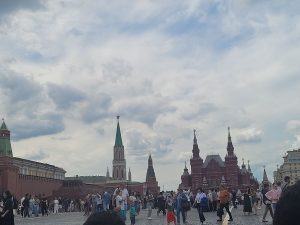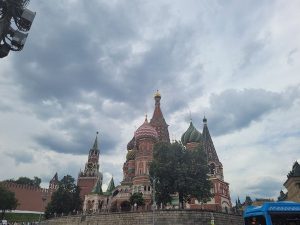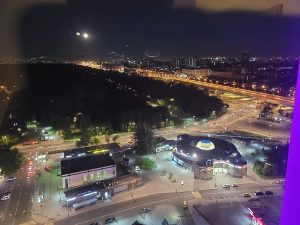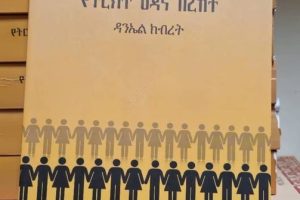
As the plane alighted at Domodedovo International Airport in Moscow, a surge of excitement and fear washed over me. This was my first time traveling outside of Ethiopia, and the total scale of the airport and the sea of unfamiliar faces made me uneasy. Yet, I took a deep breath and made my way through customs, eager to embark on this new adventure.
Once outside the airport, I found my way to the taxi stand and hopped into a cab for my hotel. As we drove through the city, I looked out the window, captivated by the sights that spread before me. The onion-domed churches, towering skyscrapers, and throngs of pedestrians hurrying along the sidewalks – it all felt so foreign, yet strangely alluring. The people seemed more disciplined and formal compared to the relaxed atmosphere I was used to back home, adding to the sense of cultural immersion.
This trip to Moscow has profoundly enriched my understanding of the city and the country. Through the New Generations program organized by Russia’s Sputnik News Agency, I had the opportunity to exchange ideas with reporters from more than twenty countries across various continents. This experience broadened my perception of the international media landscape and deepened my recognition of the Western monopoly on narrative.
One of the highlights of my visit was the trip to the Victory Museum, the largest military history museum in Russia and home to the largest collection of World War II military equipment in Europe. As I wandered through the exhibits, I was struck by the powerful and tragic account of Russia’s involvement in the conflict, as told through letters, weapons, uniforms, photographs, newspapers, and various documents.
The centerpiece of the museum is the Hall of Glory, a space that pays tribute to the heroes who participated in the Great Patriotic War, as the Second World War is known in Russia, and sacrificed their lives for their country. Visiting the upper floors of the Victory Museum, I was immersed in detailed accounts of the most important battles of the war, offering a complete journey through time.
After traveling to the Victory Museum, I ventured to the Kremlin, the political heartland of the Russian Federation. The giant, red walls and the statue of Karl Marx near the Russian parliament, the State Duma, were a testament to the country’s rich history and complex political landscape. In addition, red Square was wonderful, the architectural design of St Basils is out of this world, and if you are lucky, you will see the altering of the guard at the Kremlin.

But Moscow is not just a city steeped in history; it is also a metropolis undergoing a remarkable transformation. The city is taking significant strides towards a greener and more sustainable future, with a focus on improving its transport system and investing in green building initiatives.
One of the main priorities is the implementation of measures aimed at updating the rolling stock of urban passenger transport, along with the development of new types of stock to meet modern environmental standards. This green initiative, combined with the construction of new roads, has transformed the flow of traffic through the city, making it a more pleasant environment for urban dwellers.

In addition to motor vehicles, the city is also developing a culture of cycling through the creation of bicycle infrastructure. Electric scooters are available for rent across Moscow, representing the shared consumption economic principle. Car sharing is another convenient alternative to personal vehicles, helping to reduce greenhouse gas emissions.
The prospects for the development of green buildings in Moscow are equally promising. The city is investing in green technology, offering great potential for the advancement of innovations and environmental technologies. This commitment to sustainability is not just about building a greener future, but also ensuring a resilient and sustainable environment for its residents.
Moscow’s transformation extends beyond its transport and infrastructure. The city is already home to an abundance of green spaces, including parks, gardens, natural areas, and historic manor parks with expansive gardens. These green areas contribute to making Moscow a more livable and environmentally-friendly ecosystem for people, plants, and animals.
The urban greening project has already yielded positive outcomes, not only increasing the physical and mental health of Moscow’s residents but also maintaining biodiversity and indirectly impacting the economy and utilities. The increased urban vegetation has also made the city more resilient to the challenges of the climate crisis, counteracting water erosion, regulating runoff, improving air quality, combating urban temperature anomalies, and creating a microclimate.

While Moscow may be the most expensive city I’ve visited, I did not have enough money to purchase much. However, the exchange rates are very low, or take euros/dollars they have a better exchange rate, and they can be exchanged more easily anywhere to get rubbles, it’s important to note that due to sanctions, MasterCard and VISA cards cannot be used in Russia.
As a media professional, I was particularly interested in exploring the media landscape in Moscow. Sputnik and other Russian outlets have faced either a complete ban or flow restrictions on platforms like Facebook, X (formerly Twitter), and Google Search. However, Telegram appears to be providing a fair space for the other side of the conflict to express their voices.
My training, conducted with my international colleagues, revealed that the monopoly on media content is not exclusive to Western platforms. We examined news outlets from both Western and Russian sources, including Reuters, the Guardian, and Russia Today (RT).
Our findings highlighted the importance of checking news reports from the country we are covering and listening to voices from within, rather than solely relying on Western outlets and letting others speak on our behalf.
As I walked out of the train station and encountered the colossal concrete buildings, massive metal bridges, wide streets, and towering skyscrapers, I was struck by the sheer size and scale of Moscow. This city is a testament to the resilience, innovation, and transformative power of Russia, a nation that continues to captivate and inspire.
BY FIKADU BELAY
THE ETHIOPIAN HERALD SATURDAY 13 JULY 2024





